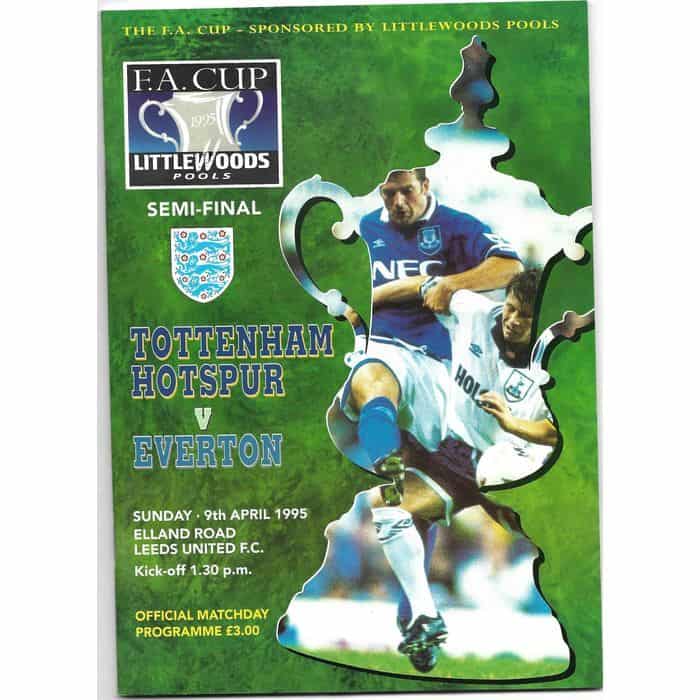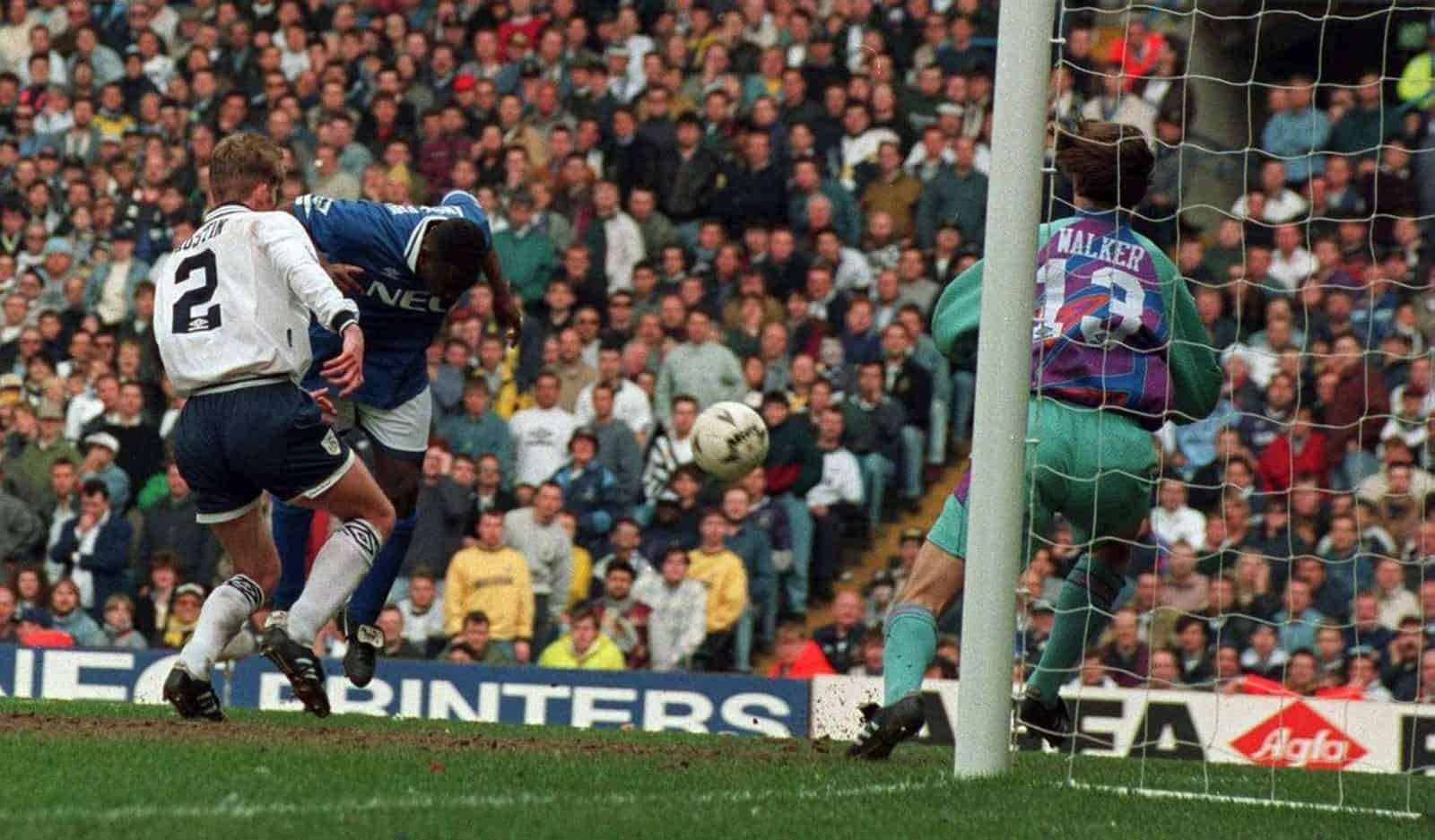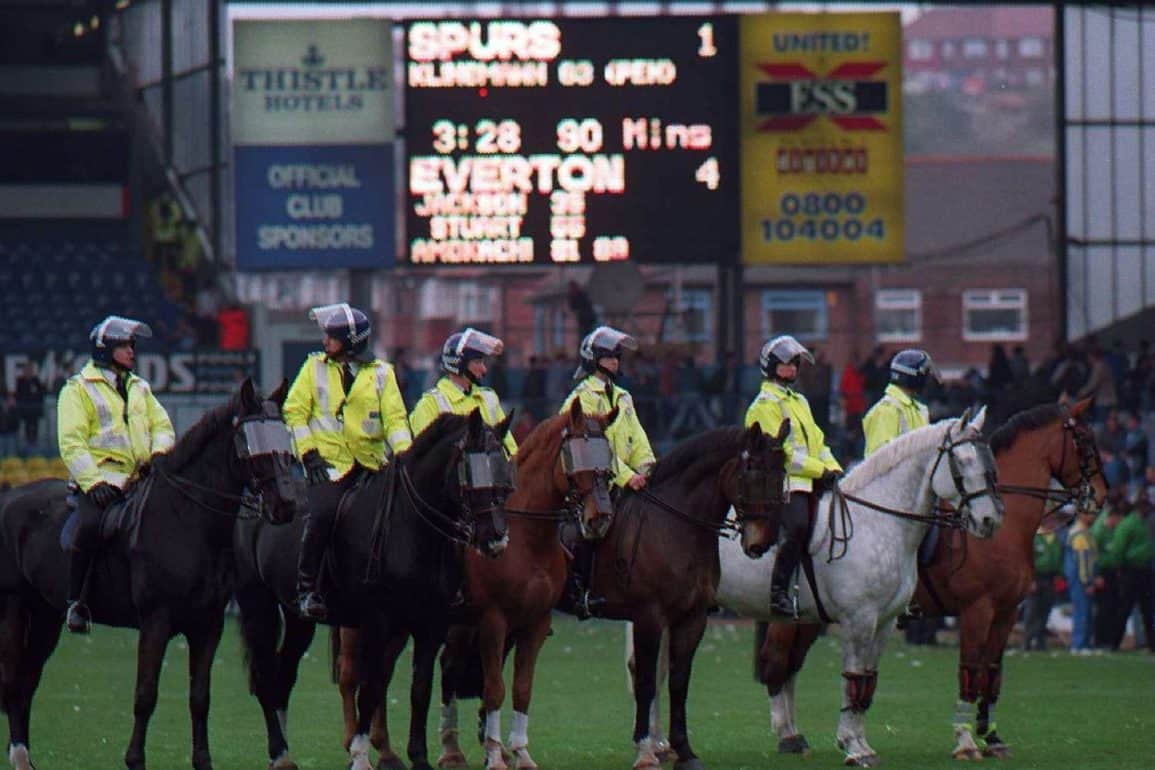Up until recent years Everton had held the record for the most number of semi-finals played in the FA Cup. While there have been a number of great Everton teams who had produced memorable FA Cup performances at the Semi-Final stage I doubt few could compare to the performance Joe Royle’s Everton team put in at Elland Road 25 years ago today. In a high octane style that had become synonymous with Royle’s Everton they simply pulverized their more fancied opponents into submission before killing them off at the back end of the game to secure an emphatic victory (that ultimately flattered Tottenham more than Everton).
The narrative that has emerged from the story, heavily re-enforced by Joe Royle himself was it was a great victory for the underdogs against the highly fancied Tottenham team. The narrative around at the time was that the dream final was Tottenham against Manchester United, and Joe Royle basked in the aftermatch press conference telling reporters that they can forget about their dream final (or words to that affect). Looking back, I think this was expert man management from Joe Royle and astute expectation management of the supporters that embodied the success Royle enjoyed. However it is worth noting, that telling people what is required to maximize a teams performance and being wholly truthful are slightly different things.
The Tottenham team on the day included the front four of England international Teddy Sheringham, German starlet Jurgen Klinsman and young starlets Nick Barmby and Darren Anderton (who was just 23). In was a front 4 that had a bit of everything you would want, the intelligence and speed of thought of Sheringham and Barmby with the killer instincts of Klinsman. They were by no means a pushover. However outside of the fabled 4 was something of a soft centre. Gary Mabbut had seen better days while Howells and Popescu could be “got at” in the middle of the park.

The numbers also don’t lie. Whole Everton went into the game significantly below Tottenham, since Joe Royle had taken over 21 games previously the two teams were very closely matched. Everton had picked up 31 points from 21 games, while Tottenham had 34 from 22 in the same period. Both sides were in the top half of the table since Royle had come to Everton, with Spurs in a slightly more promising position. When you extrapolate the data until the end of the season, Spurs would pick up 45 points from 30 games, while Everton achieved 42 from 28. In a roundabout way, even though Spurs had the superior league positioning going into the game, and the more well known and envied front line in terms of performance there had been very little between the teams after Joe Royle had implemented the changes on taking the job at Everton.
This is not meant to be a slight on Joe Royle, in fact quite the opposite. One of Royle’s great abilities as a manager was his ability to craft a narrative that allowed for his players to play in a manner that was comfortable to them- as underdogs with something of a chip on their shoulders. Royle was astute at coining the phrase “dogs of war” to describe his midfield players and would then complain when it was used in the media more broadly at underestimating their abilities as footballers. It was evidence of the sort of siege mentality and use of the press that some years later Jose Mourinho was championed for. He knew what system worked best for his team, and he engineered an aura around the team that took the pressure off them and allowed them to perform that role. Against Tottenham in the semi final, this was executed with a precision that is quite remarkable in latter stages of cup competitions.
The game plan for Everton was based around preventing Tottenham’s better players from controlling the game, and acknowledging that if this could be done, Everton could exploit some of the frailties of their opponents at the other end. As a team Everton pressed high up the pitch, and didn’t allow Tottenham to get into any flow. Alongside this they would ruthlessly exploit set pieces.
Even early into the game Everton were causing Tottenham all sorts of difficulties from corners. What strikes you about the Everton team is the physical size of it. In an era that is slightly before the sort of monsters we now see in the game Everton possessed substantial size. Watson, Unsworth, Matt Jackson and Gary Ebrell were all over 6 foot across the back 4. In front of them Joe Parkinson was around 6 ft 2 and Paul Rideout around the 6 ft but extremely competent in the air given his size. At corners both Rideout and Watson had reasonable opportunities before the first goal would come.
In the end it was young right back Matt Jackson would score, with an adept near post flick just after the half hour mark and it had certainly been coming. Jackson was one of the younger members of the right team squad and a relatively curious member of the first team. Royle had replaced him in the league with a player who had played under him at Oldham Earl Barrett. Barrett was dependable defensively but limited going forward, but represented the sort of pragmatic compromise Royle had to make to ensure his primary job (of keeping Everton up) was achieved. Fortunately for Jackson Barrett was cup tied so the young man from Luton would slot in at right back for the Cup Games.
Jackson himself in later years has acknowledged his best position was at centre back. He probably lacked the agility and positional understanding to be a top level full back though his ability to read the game had helped cover for this when he would eventually move inside and provide commendable performances in the championship for firstly Norwich City then Wigan. However at 23 he had a good engine and willingness to get forward (even if some of his end product would lack subtlety). Perhaps his most valuable attribute was his height, standing at 6 ft 3 and providing Everton another option at set pieces.
The other end of this equation was left back come left midfielder Andy Hincchliffe who possessed a fantastic left foot. To some extent Hinchcliffe was ahead of his time, in an era where fullbacks primary responsibility was to defend, his major distinguishing feature was the pace and accuracy he would deliver from dead ball situations. In this season he would finish with 14 assists, a record that only Leighton Baines and Trent Arnold can match some 25 years on.
At this point Royle had moved Hinchcliffe into midfield where he could provide some further defensive cover but still providing Everton with natural width. How Royle juggled his pack, and re-built an Everton team in such a short space of time was about as impressive an achievement that I have seen in my lifetime. While in hindsight it seems simplistic-put more tacklers into your team, become harder to beat, have more height in your team and make someone with the best delivery in the country central to what you do offensively what I have reflected upon over the last 25 years of watching football is that recognizing and enacting simplicity is never straightforward.
Everton went into half time deservedly
ahead thanks to a combination of Jacksons height and deft finish and
Hinchcliffe’s typically corner. The 2nd half would continue along
the same vein. Everton a 2nd goal just after half time when Rideout
would score a goal that was rightly ruled out due to a marginally offside goal.
What followed was a clear indication of the pressure Everton had placed upon
Tottenham was seeing them crack. From the resulting free-kick Ian Walker
misskicked the ball straight to Rideout who rushed in on goal causing Walker to
save, but fellow striker Graham Stuart followed in a swept Everton into a 2
goal lead. It was 5 touches after the disallowed goal and underpinned the
supremacy Everton enjoyed in the game.
Perhaps the only blip came around 10 minutes after this, just half the hour
mark. Dave Watson was alleged to have fouled Teddy Sheringham jumping to head a
ball away in the penalty area. The penalty was an extremely harsh one and could
well have been a free-kick to Everton due to Sheringham arching his back. While
Southall guessed the right way on the penalty and got a hand to it, the power
was too much and Klinsmann scored scored the only goal Everton would concede in
their cup run.
There was a nervy period in the game at this point. It was a lifeline Tottenham shouldn’t have been awarded and in truth didn’t deserve. At this point striker Rideout appeared to be injured, but also indicating he could continue. The message from the physio was to wait, but was misread by substitute Amokachi and the 4th official who substituted Amokachi onto the pitch concurrently with the above message being relayed. Manager Joe Royle burst off the bench and seemed to want to grab Amokachi preventing him entering the pitch and while Amokachi looked back, he was already running onto the pitch and the change was made.
At around the 80th minute point of the match, and with Tottenham pressuring the Everton goal, a chance fell to left back Stuart Nethercott which Southall saved smartly with his feet. The ball bounced out and fell to (from memory Limpar) who carried the ball forward. In a team full of giants and grafters Limpar himself was the wildcard. Inconsistent, erratic and frustrating but also blessed with unbelievable ability on his day to carry the ball forward, go past players and pick a pass. At this point, and perhaps the only point in the game Everton were railing. A game they have been comfortably in control of for an hour looked like it may be slipping away from them with the prospect of a Spurs equalizer and extra time. With ten minutes left his instruction was very much to carry the ball forward and give the Everton defence some respite.
He did just this and seemed to run down the right hand channel (ignoring the run from midfielder Graham Stuart). Level with the Spurs box he squared up the defender, cut inside and slipped a clever round the corner ball to midfielder Barry Horne who had made a forward run. He would lay the ball back to Stuart at the edge of the box who saw Amokachi unmarked, delivered the perfect cross for Amokachi to head home into an almost empty net from inside the 6 yard box. Cue an enormous outpouring of relief from the 3 sides of the ground filled with Everton supporters.

In the final minute of the game, the ball again broke to Limpar in his own half who at this point was given something of a free role where he didn’t take up defensive positions without the ball. Again he carried the ball deep into Tottenham’s half while Gary Ablett looked to make an overlap to Limpars left. Where Limpar glided across the turf, Ablett looked like he was running on treacle, and the faster his arms pumped the slower he seemed to go! Limpars pass was almost inch perfect, and a sliding Ablett slid to the ball first to square it to an open Amokachi who again was left with a tap in from 6 yards out into the roof of the net.
They were 2 perfectly executed counter attacks where the speed and power of the Everton team was perfectly matched with the intelligence and vision of Limpar. The man who had substituted himself onto the pitch had scored the clinching goals for Everton. Amokachi was inches away from adding a third a couple of minutes later, where he strode through the Spurs defence but just shot wide of the post, in what was a euphoric atmosphere amongst Everton fans.
For Everton and for Joe Royle it was perhaps the clearest exemplar of the footballing philosophy and tactical overview he had put into practice. He had inherited a side with just 1 win in 14 games, and near certainties for the drop. A mixture of pragmatism and innovation had allowed him to re-model the team to become primarily effective and latterly show bursts of quality to win games. What perhaps distinguishes this team is not necessarily it’s ability (there have been a number of Everton sides who have finished in the top half) but the turnaround was pronounced and the side were able to carry out instructions in the biggest of games.
In a broader sense, the changes Royle had made were thoroughly vindicated, in the clearest way on the biggest stage. The centrality of Hinchcliffe’s set piece delivery and additional height across the side would give Everton the lead. The high press game, exemplified by being more robust than opponents swamped their opponents. The fact he elected to keep the flair of Limpar but ultimately give him a better structure and more protection allowed him to shine as games became stretched. It was a clear example of the synthesize between having a workable plan and putting the right pieces in the right places.
Following that game Everton would remain unbeaten until the end of the season (a 9 game run) and would only concede in one other game. It would be a run that would see them lift the FA Cup and secure their safety from an almost impossible position in the November of that year. Royle began to settle on a structure of a back 8, with the same back 4, goalkeeper and protecting 2 midfielder players and left back Hinchcliffe being preferred for the majority of the run in (with Earl Barrett and Matt Jackson alternating for league and cup games).
While it was far from the all conquering sides that Everton had produced in the previous decades, the performance itself was as decisive and emphatic as any an Everton side has produced in a big game. I would also say, for Everton fans who perhaps missed some of the greatness of the 1980’s it presented a template for what we expect from our teams, (effort, passion and aggression) in a way that few other teams have. While the tag of overwhelming underdogs was in my mind overly simplistic, it has been something we have taken on board and outside of the context of 1995 is not as easy or effective a label to adopt. However 25 years on, the performance should rightly be remembered by Evertonians young and old as a great moment in our recent history.


